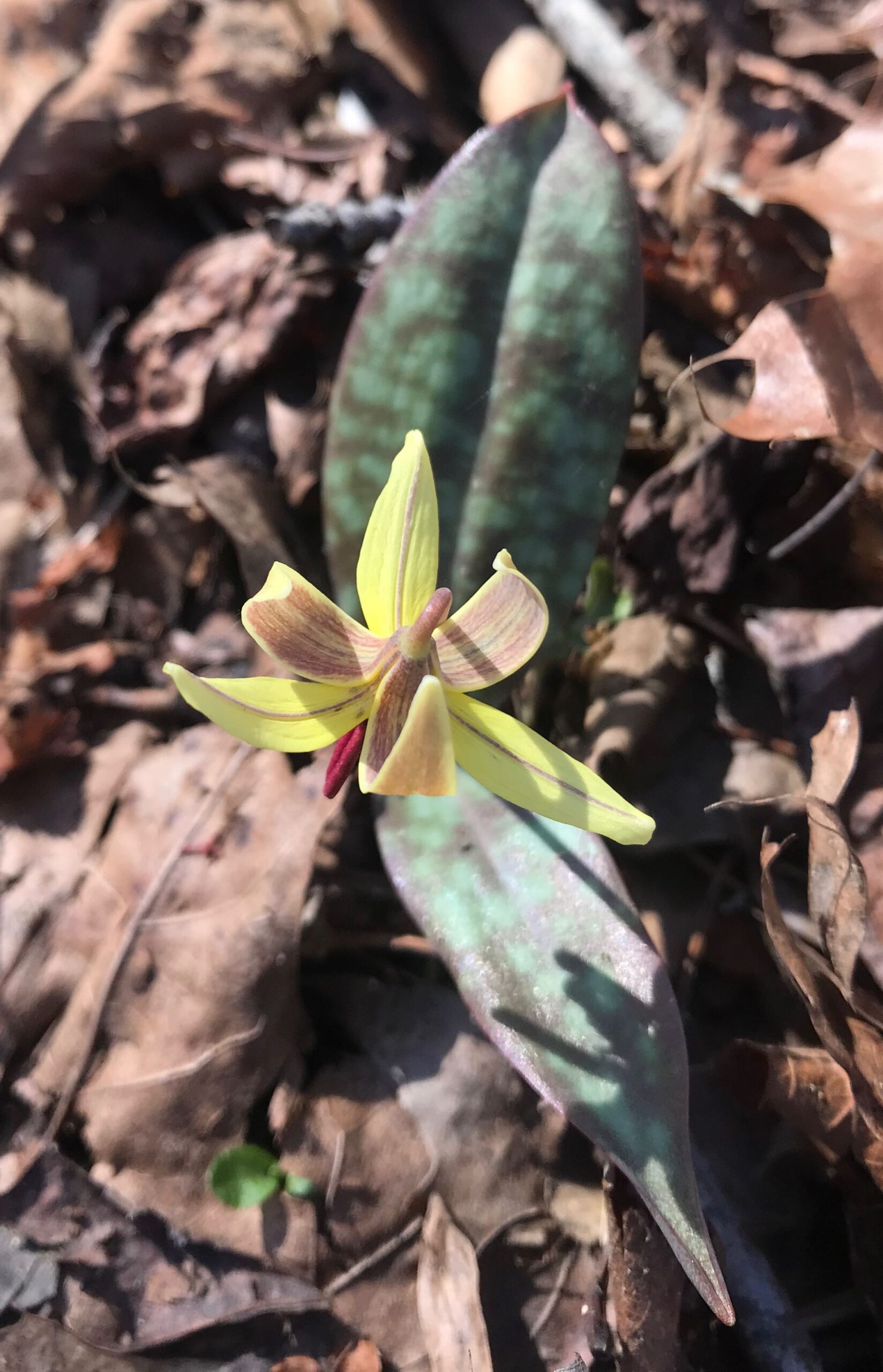
My official first sighting of a spring wildflower, last Friday, comes with an asterisk, like a home run record set on steroids: the temperature had skyrocketed to near 80 and sunlight drenched the bottomland forest floor. It was a tease no trout lily, the first responder of spring wildflowers, could resist. And so it was, that at 11:58 a.m. on the Poet’s Walk in Hillsborough that I spotted my first spring wildflower of the season.
As a kid, I didn’t let myself start thinking about spring and warmer weather until pitchers and catchers reported in early February. In college, my cue was spring break (which actually started me thinking about summer break). Now, my thoughts turn to spring when I spot the first delicate yellow and maroon petals unfurl from between mottled green and purple leaves, a presentation akin to that of its namesake fish).
In the Piedmont, the trout lily tends to be the first wildflower of spring. You may see other flowers in the wild beforehand, but those are introduced plants, hardy perennials planted by hardy homesteaders in need of a splash of color in the gray landscape. Find daffodils in the woods, for instance, and odds are good you may find the remains of a stone foundation or the depression of a root cellar nearby. True wildflowers, not these interloping ornamentals, are nature’s way of assuring us that spring is nigh.
Spotting the first trout lily is a matter of knowing when and where to look. I start looking after the first few 60 degree days of February. I’ve seen them as early as Feb. 10 (last year, along the Eno River), more frequently around the 20th. They tend to like moist, rich soil; mature bottomland forest near a stream is a good place to start looking. They’ll bloom for about two weeks, maybe three.
Soon, the trout lily will be joined by the spring beauty, which also has a fondness for bottomlands. Whereas trout lilies grow in small gatherings, spring beauties can carpet the forest floor with their delicate white petals, sometimes tinted or veined in pink. There’s a bit of optical hocus-pocus with spring beauties: it may take a moment to spot your first, but then you see them everywhere. Spring beauties can be confused with other early bloomers with delicate white flowers, including the field pansy and toothwort.
Also competing for your attention at the start of spring are speedwells, field pansies, periwinkles, hepatica and violets, all coming in a range of purple and blue hues. While all are ephemeral, some are less so than others, Pity the common blue violet? “Underappreciated,” says the Eno River Association, ”because it occurs so many places — begins blooming early and persists into the summer in favorable habitats.”
By design, the spring wildflower display tends to start in low-lying areas. It’s incumbent upon these forest-floor dwellers to bloom early while they can still get a healthy dose of sunshine. Once those towering hardwoods — elms, ash, certain oaks — leaf out, the nurturing sunlight dims on the forest floor.
Where to look
Now that the show has gotten underway, where’s a good place to catch it? Five suggestions.
- Pump Station Access, Eno River State Park, Durham. The 1.5-mile Pump Station Trail passes through a rich bottomland forest where carpets of wildflowers will be rolling out soon. More info here.
- Johnston Mill Nature Preserve, Chapel Hill. Three miles of trail take you through meadows, fringe forest, the New Hope Creek floodplain and other locals where spring wildflowers flourish. More info here.
- Penny’s Bend Nature Preserve, Durham. Located on a peninsula formed by an oxbow in the Eno River, the site “boasts a showy display of spring ephemerals,” says the Eno River Association, including Dutchman’s breeches, false rue anemone, bloodroot and more. More info here.
- Reedy Creek Park & Nature Preserve, Charlotte. The trails off the Nature Center provide access to a lush bottomland forest rich with spring wildflowers. More info here.
- Knight Brown Nature Preserve, southwestern Rockingham County north of Greensboro. A lush wooded valley lies at the heart of this 189-acre preserve, a valley with easy trail access. More info here.
Show us your wildflowers!
Catching some of the early spring wildflower action? Share your photos and where you’re seeing the blooms on our Facebook page.
